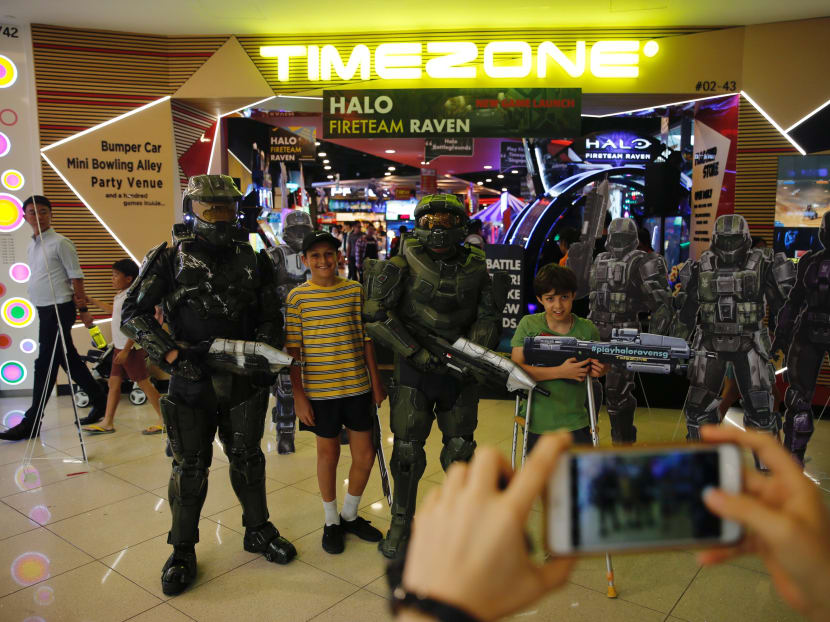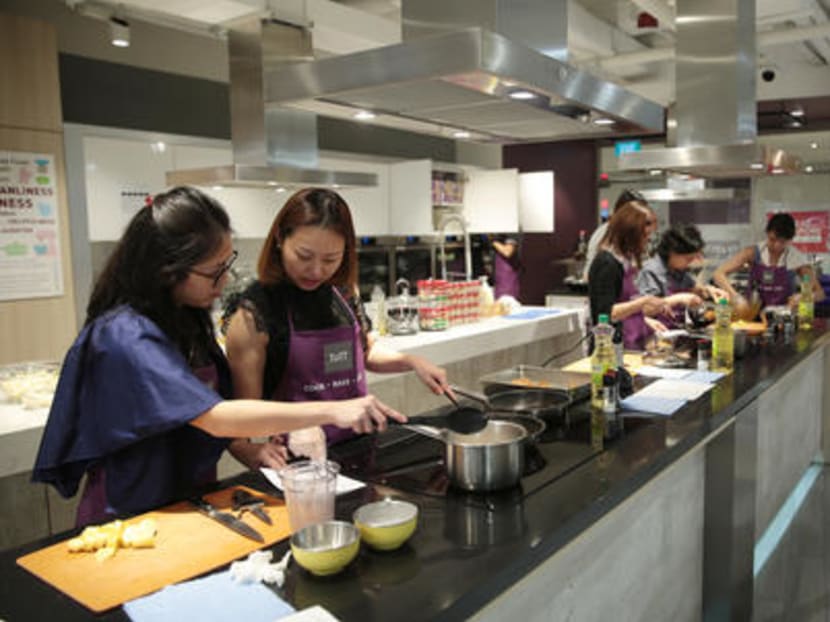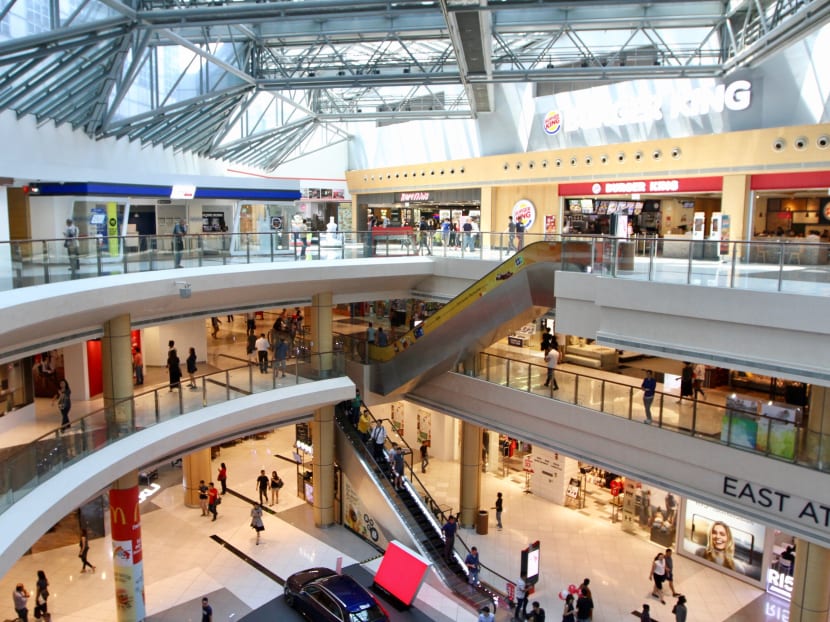The Big Read: Malls change tack to draw crowds, never mind if they aren’t there to shop
SINGAPORE - Under siege by e-commerce, retail malls have turned to activity-based retailers to try and bring the crowds back. Studios — teaching anything from pole dancing and pilates to cooking and crafts — as well as mega gyms, for example, have been sprouting up in shopping centres and mixed-use developments. Arcade centres, too, are seeing a revival.
SINGAPORE — With the rise of e-commerce, Ms Sabrina Poh, 25, had few reasons to set foot in a shopping mall in recent years, buying almost everything she needs online.
However, that changed in March when pole dancing studio Brass Barre took up 3,300 sq ft of floor space at Orchard Gateway.
Now, she heads to the mall at least once a week, and finds herself lingering in the shopping centre and picking up a few items every now and then.
“If the studio wasn’t there, I wouldn’t frequent that mall,” said Ms Poh, who works in public relations.
Ms Poh is not alone. Droves of consumers are heading to the malls throughout the week — not primarily to shop but to attend classes, do yoga or work out in the gym.
Of late, studios — teaching anything from pole dancing and pilates to cooking and crafts — as well as mega gyms, for example, have been sprouting up in shopping centres and mixed-use developments. Arcade centres, too, are seeing a revival after they had gone out of vogue.
The influx of such activity-based retailers are no coincidence or a passing fad.
Under siege by e-commerce, retail malls have been forced to shift their strategy to entice people to step through their doors.
The Brass Barre is one of several health and fitness outfits that have been increasing their presence in Singapore’s retail landscape. In particular, mega fitness chains such as Fitness First, Virgin Active and Anytime Fitness have expanded rapidly across the island in the last few years, in developments in the Central Business District as well as suburban malls.
Culinary-themed stores, such as kitchenware retailer ToTT and ABC Cooking Studio, are also popping up in various malls.
In January, Timezone opened its flagship outlet at Vivocity, occupying 12,000 sq ft, and complete with bowling alleys and bumper cars.

Family amusement arcade Timezone is seeing a resurgence in popularity in recent years. Photo: Jason Quah/TODAY
Property analysts said there is limited data on how much floor space is taken up in malls by activity-based retailers. Nevertheless, the growth of these tenants compared to, say, five years ago, is noticeable, they added.
Depending on the size and location of a mall, these retailers currently take up between 30 per cent and 40 per cent of overall floor space, said Knight Frank’s head of retail Wendy Low.
And it is not just the new tenants. Traditional retailers are also putting a new spin on their offerings.
For example, Japanese fashion retailer Lumine, which opened in The Central in November last year, offers craft workshops in its store; active apparel wear Lululemon conducts yoga classes; and luxury brand Gucci allows customers to personalise their bags with a do-it-yourself section at its Ion Orchard store.
Ms Low also cited Emporium Shokuhin in Marina Square, which has “reinvented the idea of a departmental store”. The shop has a live seafood market, beef dry-aging facility, Japanese grocer and various dining concepts.
It has also sought to personalise the customer experience by letting patrons pick seafood fresh out of the tank, and have a chef prepare it to their individual taste.
With the myriad of offerings online, shoppers are now spoilt for choice, and doorstep deliveries have also meant there is little incentive for consumers to “take the extra step to drop by a mall”, Ms Low said.
“To compete effectively, landlords need to curate a personalised experience for shoppers to attract footfall and incentivise a trip down to the mall,” she said.
Ms Christine Li, senior director of research at Cushman & Wakefield, reiterated that the need for landlords to curate better shopping experiences has resulted in more activity-based retail experience at malls to “constantly engage customers”.
“Craft workshops, culinary classes and fitness activities are increasingly popular with landlords as they are able to bring in regular footfalls and keep (consumers) longer in the malls as well,” she added.
MALLS UNDER SIEGE
Much has been said about the decline of brick-and-mortar retailers around the world, including in Singapore.
Once a famed shopping haven for Singaporeans and tourists alike, Orchard Road, for example, is now a pale shadow of itself. The Republic’s premier shopping belt is the subject of a S$1.3 million study being conducted by Australian urban planning consultancy firm Cistri.
Cistri recently won the tender awarded by the Singapore Tourism Board and the Urban Redevelopment Authority to rejuvenate the 2.2km shopping belt. The six-month study began in April and a blueprint for the area — spanning the next 15 to 20 years — is expected to be unveiled later this year.
While footfall is relatively high in suburban malls, which serve large residential catchment areas, retailers have bemoaned the lack of sales. Many customers, in fact, have taken to browsing at brick-and-mortar stores to check out the items before making their purchases online.
As a reflection of the lacklustre retail scene, rents in the central region have fallen by 17.1 per cent in the second quarter of this year, since they peaked in the fourth quarter of 2014.
Over the same period, vacancy rates have increased from 5.8 per cent to 7.3 per cent, or about 4.8 million sq ft of vacant retail space as of June.
Rents in the central region had declined for 12 consecutive quarters, before seeing a slight uptick of 0.1 per cent in the first quarter of this year. But normal service resumed in the following quarter, as rents dipped by 1.1 per cent between April and June, based on statistics from the Urban Redevelopment Authority released on Friday.
In response to the e-commerce threat, malls have turned to food and beverage (F&B) retailers to draw people back through their doors.
But with the proliferation of food delivery services, developers have been forced to come up with something else. At the same time, the falling rents have opened up an opportunity for non-traditional mall retailers — which do not have high sales per square foot — to come in and set up shop.
Ms Li said that landlords used to “place more emphasis” on growing income through higher rents, “which resulted in cookie-cutter malls which are more efficient and are able to fetch higher rental”.
“This has changed with the evolution of shopping,” she added. With more transactions taking place online, malls have to go beyond that and offer an experience desired by shoppers, she noted.
SELLING AN EXPERIENCE
In addition to strategies that malls and retailers have been employing over the last few years – such as pop-up stores and “click and collect services” – one common approach in recent times has been the creation of activity-based spaces for like-minded people to gather, experts say.
For instance, the number of fitness studios in shopping centres has been on the rise.
From new entrants – six-month-old Fight Zone, for instance, is already planning to open two more centres by the end of this year – to established centres, these providers have been expanding to meet demand.
Launched in 2003, Fitness First now has 19 clubs, half of them in malls. Next week, it will open its 20th outlet at SingPost Centre in Paya Lebar, occupying 12,000 sq ft of floor space.
Anytime Fitness, which offers 24/7 gym access, has been expanding aggressively since opening in 2013. Its 50th outlet will open at the end of September.
Each gym has about 1,000 members, said its marketing associate Alicia Ng. That translates to a total of about 50,000 active customers.
Fitness club Virgin Active has grown from its first centre at One Raffles Place in 2013 to five gyms, situated mainly in mixed-use developments and shopping malls. Its total floor area has more than tripled to 109,000 sq ft in five years.
Its Southeast Asia managing director Christian Mason said membership has more than doubled after it opened four clubs in the last two years. As of June, Virgin Active has close to 10,000 members.
He added that Virgin Active has invested up to S$100 million to open at least eight clubs by 2022.
While fitness centres grow from strength to strength, gaming centres are making a comeback at shopping malls as part of the push by developers to offer activity-based retail experiences.
Once a fixture in Singapore’s malls, Timezone — an international chain of family amusement arcade centres — saw a slowdown in its business in the early 2000s due to the popularity of in-home gaming options, said its chief customer officer Caroline Leong.
But business has picked up significantly of late. Since April last year, Timezone has opened five new outlets, doubling its total number across the island.
The latest is its 11,800 sq ft flagship gaming centre in Vivo City. A new outlet will open in Jurong Point at the end of August. There are now over 2 million active customers across all its outlets, a 5 per cent increase over last year, said Ms Leong.
Amid the push by landlords to offer activity-based retail experience, the introduction of high-tech gaming options, for example, has also led to renewed interest in arcade centres in general.
Zero Latency, which opened in November last year, uses virtual reality to bring gamers into a zombie world. Wearing a headset, gamers are able to roam freely in a 2,100 sq ft space. The store has seen over 15,000 customers since launch.
Mr Simon Ogilvie, executive director of Tomorrow Entertainment which brought in Zero Latency from Australia, said there is a rise in commercial-grade entertainment centres as there are limitations to what in-home game consoles can do. “Experience-based tenants are valuable for malls,” he noted.
Meanwhile, culinary-themed retailers are also making strides in shopping malls.
Beyond its retail services, Kitchenware store Tott — which started out in Bukit Timah six years ago — offers cooking classes for the public and for corporate team bonding activities.

Participants at a cook-off event at Tott in Suntec City on July 26, 2018. Photo: Jason Quah/TODAY
It has two outlets now, both of which are at shopping malls — Suntec City and Century Square.
Its director Grace Tan said there has been a 32 per cent increase in its membership base from 2016 to date. “Besides the convenience and accessibility of shopping malls for our customers, we also appreciate the shopping mall marketing teams who work closely with their tenants to drive traffic,” she said.
ABC Cooking Studio, which opened in Takashimaya three years ago, is opening another outlet in Westgate next month. The school has close to 10,000 members. The number of students it sees each month has increased from 2,000 in the first year, to 5,000.
The firm’s regional marketing manager Karen Chong said: “We saw an increasing trend where consumers are actively seeking for hands-on activities to gain some experience. … ABC is offering experiences such as face-to-face interaction and learning of new skills, that cannot be replaced by Internet and social media.”
Keen to tap on the growing interest in such experience-based activities, do-it-yourself baking studio Funsiamo will open in August.
Rather than requiring customers to book baking slots, Funsiamo allows customers to walk in anytime to the 1,200 sq ft studio and learn how to bake from recipes provided on iPads, said master franchisee Desmond Ling, who brought in the concept from Taiwan.
Ms Li, from Cushman & Wakefield, noted that some retailers are also using social media to build a more intimate relationship with customers and improve their shopping experience.
Others are also tapping on augmented or virtual reality, she added. Homegrown furniture store Commune, for example, recently introduced VR and 3D-planning services at its retail store, so that shoppers can visualise how the furniture and furnishings look in their homes.
Automation is also another trend hitting the retail scene, with more automated vending machines being seen in shopping malls in recent months, Ms Li said.
‘NOT ENOUGH’ TO TURN THE TIDE
Consumers whom TODAY spoke to were divided over whether the malls are doing enough to draw them back.
Mr Darryl Lim, 28, said the proliferation of activity-based retailers changes the experience of window shopping. “You don’t just walk, but (get to) try new things,” he said.
Ms Nurul Syuhuda, 20, said she was running out of ideas about what she can do with family and friends for leisure, and the hands-on activities could help her bond with her loved ones. “Window shopping is boring,” she added.
However, Ms Koh Xiu Ming, 24, did not think such activities would entice her to make more trips to the malls, adding that they do not make “much of a difference”.
Ms Daphne Lim, 36, said that while she enjoys craft workshops and welcomes such activities being offered, they were not compelling enough to make her frequent the malls.
The experts believe that Singapore’s shopping centres need to do a lot more to transform the retail scene, which is lagging behind places such as Hong Kong, some cities in China and Dubai.
For example, Dubai Square, which opened last week, features fashion stores with smart fitting rooms that come with interactive mirrors and personalised recommendations using artificial intelligence. Shoppers can order food and drinks from eateries using apps, saving them the need to queue and wait. Via the apps, they can also buy items from the stores — which are described as “showrooms” — and collect them later.
Ernst & Young consumer products and retail leader Chandan Joshi described the Singapore malls’ current game plan of changing their tenant mix as “small, incremental steps”, which have prevented footfalls from declining and stabilised occupancy rates.
But with a significant supply of new retail space coming onstream in the next two to three years, he warned that the sector has to innovate more to stop occupancy rates from falling.
“We are not going as far to innovate on the experiential side… We’re not at the cutting-edge of this experience, rather we’re just followers,” he said. “Truly innovative, revolutionary retail is almost missing in Singapore.”
There is also the question of how sustainable the current strategy is, the experts said.
While rentals are expected to stay low as the retail scene tries to get back on its feet, higher rents could make business untenable for activity-based retailers, which do not generate high sales on a per square foot basis.
Nevertheless, the experts noted that this would depend on a few factors such as how innovative the affected concept stores are, whether they are smaller retailers or large global brands with deep pockets, as well as the negotiations between landlords and tenants.
Overall, the experts reiterated that there are several obstacles hindering the transformation of the retail sector here, including the payments infrastructure.
Said Ms Li: “In Singapore because of payment issues, and malls having different loyalty programmes, people have been slow to embark on the journey (of transformation)… Over the next one or two years, the priority is for Singapore to get onto one single payment platform.
While on the decline, the rentals in malls are still relatively high. And this limits the scope for retailers to experiment with novel concepts, Ms Li added.
Mr Chandan felt that the need to revolutionise the retail scene has not hit home, because retailers and landlords are not desperate yet.
“To some extent because of the weather and the location, there is almost a compulsive need to go to a mall… There are not many other places to go to (in Singapore), so the families still end up in the malls anyway,” he added.
But he stressed: “A mindset shift is needed… (retailers and landlords) should view retail disruption as an opportunity rather than as a threat.”









